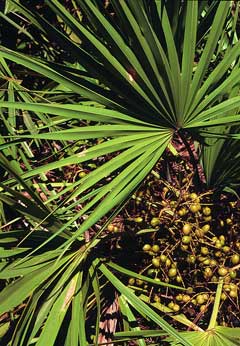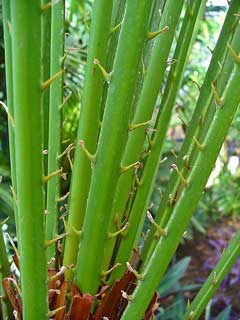 |
|
Forest Plants of the Southeast and Their Wildlife Uses by J.H. Miller and K.V. Miller, published by The University of Georgia Press |
 |
| http://commons.wikimedia.org/wiki/User:Llez |
Translate this page:
Summary
Bloom Color: White. Main Bloom Time: Early spring, Late spring, Mid spring. Form: Palm.
Physical Characteristics

 Serenoa repens is an evergreen Shrub growing to 3 m (9ft) by 2 m (6ft) at a slow rate.
Serenoa repens is an evergreen Shrub growing to 3 m (9ft) by 2 m (6ft) at a slow rate.
See above for USDA hardiness. It is hardy to UK zone 8. It is in leaf all year. The species is hermaphrodite (has both male and female organs).
Suitable for: light (sandy), medium (loamy) and heavy (clay) soils and prefers well-drained soil. Suitable pH: mildly acid, neutral and basic (mildly alkaline) soils and can grow in saline soils.
It cannot grow in the shade. It prefers moist soil. The plant can tolerate maritime exposure.
UK Hardiness Map
US Hardiness Map
Synonyms
Brahea serrulata. Chamaerops serrulata. Corypha obliqua. Serenoa serrulata
Plant Habitats
Woodland Garden Sunny Edge;
Edible Uses
Edible Parts: Fruit Seed
Edible Uses:
Fruit - raw or cooked[238]. A sweet flavour but with a soapy taste and a strong vanilla-like aroma[238]. Regular consumption of the fruit is supposed to be very beneficial to the health, improving the digestion and helping to increase weight and strength[238]. Seed - raw or cooked[238].
References More on Edible Uses
Medicinal Uses
Plants For A Future can not take any responsibility for any adverse effects from the use of plants. Always seek advice from a professional before using a plant medicinally.
Antiseptic Aphrodisiac Diuretic Expectorant Sedative Tonic Urinary Uterine tonic
Saw palmetto berries are a tonic herb that is used in the treatment of debility, urinary tract problems and for reducing enlarged prostate glands[254]. The partially dried ripe fruit is aphrodisiac, urinary antiseptic, diuretic, expectorant, sedative and tonic[4, 222]. It is taken internally in the treatment of impotence, debility in elderly men, prostate enlargement and inflammation, bronchial complaints associated with coldness, and wasting diseases[222, 238]. Saw palmetto is one of the few Western herbs that are considered to be anabolic (strengthening and building body tissue and encouraging weight gain)[254]. The fruit pulp, or a tincture, is given to those suffering from wasting disease, general debility and failure to thrive[254]. The fruit also has a beneficial effect on the urinary system, helping to reduce the size of an enlarged prostate gland and strengthening the neck of the bladder[254]. The fruit has a probable oestrogenic action, it is prescribed in the treatment of impotence, reduced or absent sex drive and testicular atrophy in men and to stimulate breast enlargement in women[254]. The fruit is also used in the treatment of colds, coughs, irritated mucous membranes, asthma etc[4, 222]. A suppository of the powdered fruits, in cocoa butter, has been used as a uterine and vaginal tonic[222]. The German Commission E Monographs, a therapeutic guide to herbal medicine, approve Serenoa repens Saw Palmetto for prostatic complaints, irritable bladder (see [302] for critics of commission E).
References More on Medicinal Uses
The Bookshop: Edible Plant Books
Our Latest books on Perennial Plants For Food Forests and Permaculture Gardens in paperback or digital formats.

Edible Tropical Plants
Food Forest Plants for Hotter Conditions: 250+ Plants For Tropical Food Forests & Permaculture Gardens.
More

Edible Temperate Plants
Plants for Your Food Forest: 500 Plants for Temperate Food Forests & Permaculture Gardens.
More

More Books
PFAF have eight books available in paperback and digital formats. Browse the shop for more information.
Shop Now
Other Uses
Basketry Brush String
The leaf stems have been used in making baskets[257]. The plant has been used to make brushes and cordage[257].
Special Uses
References More on Other Uses
Cultivation details
Landscape Uses:Border, Erosion control, Ground cover, Massing, Specimen, Woodland garden. Requires a warm sunny position in a moist but well-drained soil[231]. Plants can succeed in quite dry soils so long as their roots can penetrate to underground water[231]. Growing mainly in coastal areas in its native range, this species is likely to be very tolerant of maritime exposure, though not of cold winds[K]. This species is one of the hardiest of palms and succeeds outdoors in warm temperate zones[200]. It is only likely to be marginally hardy, even in the mildest areas of Britain, and probably tolerates temperatures down to between -5 and -10°c[K]. Palms usually have deep penetrating root systems and generally establish best when planted out at a young stage. However, older plants are substantially more cold tolerant than juvenile plants[231]. In areas at the limit of their cold tolerance, therefore, it is prudent to grow the plants in containers for some years, giving them winter protection, and only planting them into their permanent positions when sheer size dictates[231]. Palms can also be transplanted even when very large. Although the thick fleshy roots are easily damaged and/or desiccated, new roots are generally freely produced. It is important to stake the plant very firmly to prevent rock, and also to give it plenty of water until re-established - removing many of the leaves can also help[231]. Plants usually sucker freely in the wild and form dense thickets[200]. Special Features:
Attractive foliage, North American native, Attracts butterflies, Fragrant flowers, Attractive flowers or blooms.
References Carbon Farming Information and Carbon Sequestration Information
Temperature Converter
Type a value in the Celsius field to convert the value to Fahrenheit:
Fahrenheit:
The PFAF Bookshop
Plants For A Future have a number of books available in paperback and digital form. Book titles include Edible Plants, Edible Perennials, Edible Trees,Edible Shrubs, Woodland Gardening, and Temperate Food Forest Plants. Our new book is Food Forest Plants For Hotter Conditions (Tropical and Sub-Tropical).
Shop Now
Plant Propagation
The seed is best sown in a warm greenhouse as soon as it is ripe. It usually germinates freely. Stored seed is more difficult to germinate, it should be pre-soaked for 24 hours in warm water before sowing in a warm greenhouse. When they are large enough to handle, prick the seedlings out into individual pots and grow them on in the greenhouse for at least their first two winters. Plant them out into their permanent positions in late spring or early summer, after the last expected frosts. Although the plant forms suckers, these do not usually transplant well and so seed is the only sure method of propagation[200].
Other Names
If available other names are mentioned here
Native Range
NORTHERN AMERICA: United States (Alabama (south), Florida, Georgia (southeast), Louisiana (southeast), South Carolina, Mississippi (south))
Weed Potential
Right plant wrong place. We are currently updating this section.
Please note that a plant may be invasive in one area but may not in your area so it's worth checking.
Conservation Status
IUCN Red List of Threatened Plants Status :

Growth: S = slow M = medium F = fast. Soil: L = light (sandy) M = medium H = heavy (clay). pH: A = acid N = neutral B = basic (alkaline). Shade: F = full shade S = semi-shade N = no shade. Moisture: D = dry M = Moist We = wet Wa = water.
Now available:
Food Forest Plants for Mediterranean Conditions
350+ Perennial Plants For Mediterranean and Drier Food Forests and Permaculture Gardens.
[Paperback and eBook]
This is the third in Plants For A Future's series of plant guides for food forests tailored to
specific climate zones. Following volumes on temperate and tropical ecosystems, this book focuses
on species suited to Mediterranean conditions—regions with hot, dry summers and cool, wet winters,
often facing the added challenge of climate change.
Read More
Expert comment
Author
(W.Bartram.)Small.
Botanical References
200
Links / References
For a list of references used on this page please go here
Readers comment
| Add a comment |
|
If you have important information about this plant that may help other users please add a comment or link below. Only comments or links that are felt to be directly relevant to a plant will be included. If you think a comment/link or information contained on this page is inaccurate or misleading we would welcome your feedback at [email protected]. If you have questions about a plant please use the Forum on this website as we do not have the resources to answer questions ourselves.
* Please note: the comments by website users are not necessarily those held by PFAF and may give misleading or inaccurate information.
To leave a comment please Register or login here All comments need to be approved so will not appear immediately.
|
|